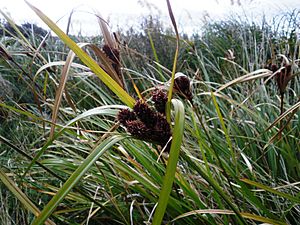Giant umbrella-sedge facts for kids
Quick facts for kids giant umbrella-sedge |
|
|---|---|
 |
|
| Scientific classification | |
| Genus: |
Cyperus
|
| Species: |
ustulatus
|
| Synonyms | |
|
|
The Cyperus ustulatus, often called the giant umbrella-sedge or coastal cutty grass, is a type of sedge plant. It is native to New Zealand. This plant usually grows in areas near the coast or in low-lying lands close to water. You can find it on the North Island and the Kermadec Islands.
Contents
What is the Giant Umbrella-Sedge?
The giant umbrella-sedge is a tall plant that belongs to the sedge family. Sedges are a group of grass-like plants. They often grow in wet places like swamps or along riverbanks. This plant is known for its strong, upright stems.
Where Does It Grow?
This plant loves wet environments. It is commonly found in coastal areas. It also grows in lowland regions of New Zealand. You will often see it near lakes, rivers, or wetlands. It thrives in places where there is plenty of moisture.
What Does It Look Like?
The leaves of the giant umbrella-sedge are quite wide. They are also shiny and often folded. After it flowers in the summer, the plant produces long, dark brown seed heads. These seed heads grow in a cluster. They are held up by a group of leaves at the very top of the plant.
Life Cycle and Reproduction
The giant umbrella-sedge flowers during the summer months. After flowering, it develops its distinctive seed heads. These seed heads contain the seeds. The seeds help the plant to reproduce and spread. This allows new plants to grow in suitable wet areas.
Māori Name and Uses
The Māori name for this plant is toetoe upoko-tangata. It is important to know that the name toetoe by itself usually refers to a different group of plants. Those plants are called Austroderia. They belong to the grass family, which is different from sedges.
Historically, the toetoe upoko-tangata plant was very useful to Māori people. Along with another plant called raupō (Typha orientalis), its strong stems were used. They were a key material in making traditional kites. This shows how important native plants were in daily life and culture.

